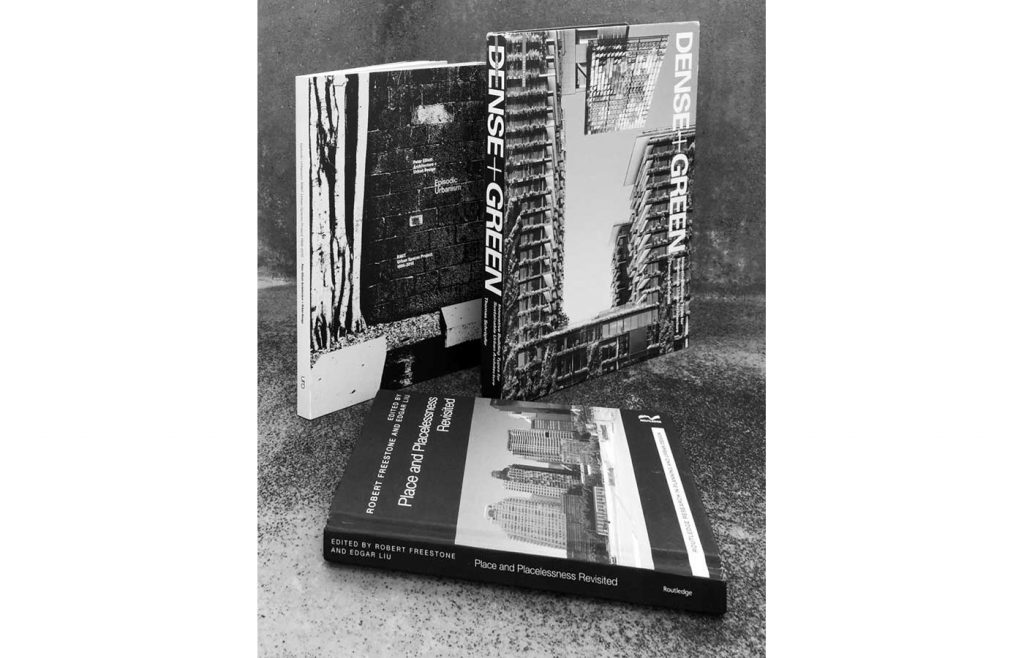



table of contents

previous articles

next articles
Feature article



CONTENTS
- From Episodic Urbanism: Peter Elliott Architecture + Urban Design designed A’Beckett Urban Square in Melbourne as a temporary recreational space. RMIT University opted to turn this previously underutilised and derelict space into a publicly accessible 2,800 m2 park incorporating multi-use sports courts with spectator seating. A specially commissioned large-scale artwork by artist Ash Keating covers the walls that wrap the site on two sides. Courtesy Uro Publications
Selected Titles on Urbanism and Placemaking
Dense + Green: Innovative Building Types for Sustainable Urban Architecture
Thomas Schröpfer
Birkhaüser Verlag
The integration of nature into architecture is a key concern for sustainability. Yet all too often sustainable design is reduced to improving the energetic performance of buildings and the ornamental application of natural green. Dense + Green explores new architectural typologies that emerge from the integration of green components, such as sky terraces, vertical parks and green facades, in high-density buildings. Featured on the cover is the Central Park highrise by Jean Nouvel in collaboration with French botanical artist Patrick Blanc. Compiled by Thomas Schröpfer, Professor of Architecture and Sustainable Design at the Singapore University of Technology and Design, Dense + Green is a key reference work on sustainable urban architecture, presenting successful case studies by leading international authors, practitioners and scholars. The book describes green strategies across different design tasks and climate conditions. Expert essays complement detailed international case studies, all illustrated with informative drawings and photographs, which demonstrate the current paradigm shift in sustainable urbanism.
Episodic Urbanism: The RMIT Urban Spaces Project 1996–2015
Peter Elliott et al.
Uro Publications
Episodic Urbanism is a book about the transformation of two city blocks in the heart of Melbourne, alongside the transformation of an educational institution. Over the course of nearly two decades, Peter Elliott Architecture + Urban Design has worked to turn RMIT University’s inner-city premises from a private fortress into a public-spirited urban campus. RMIT’s rejuvenation sits in stark contrast to typically homogeneous masterplanning exercises, and the book tells a story about how we might create dramatic transformation within our cities without dramatic rupture; subtle, incremental changes respect existing conditions and their history. Thoughtfully designed by celebrated graphic artist Stuart Geddes, Episodic Urbanism features contributions from leading urban thinkers, including Leon van Schaik, William L Fox, SueAnne Ware and Robert Nelson. This is an essential publication for those with an interest in how we can better shape our cities, not through erasure and homogenisation but with an appreciative eye to history, diversity and vitality. As Peter Elliott puts it: ‘One city block is like a little experiment in how you reimagine a city.’
Place and Placelessness Revisited
Edited by Robert Freestone and Edgar Liu Routledge
Since its publication in 1976, Edward Relph’s Place and Placelessness has been an influential text in thinking about cities and city life across disciplines, including human geography, sociology, architecture, planning and urban design. For four decades, ideas put forward by this seminal work have continued to be discussed, from the concept of placelessness itself through how it plays out in our societies to how city designers might respond to its challenge in practice. Drawing on evidence from Australian, British, Japanese and North and South American urban settings, Place and Placelessness Revisited is a collection of first-hand research and theoretical discussions of contemporary applications and interpretations of place and placelessness. It takes a multidisciplinary approach – covering architecture, environmental psychology, geography, landscape architecture, planning, sociology and urban design – in critically revisiting placelessness in theory and its relevance for twenty-first century contexts. The book includes essays by Relph, 13 authors from Sydney and Melbourne, and others from the UK and Canada.
Members receive 10% discount via the booksellers from Archibooks: architecture.com.au/services/archibooks












